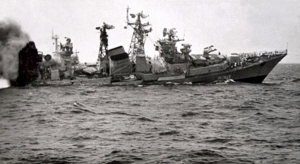1981 Daekanese-Urranese conflict
Jump to navigation
Jump to search
| 1981 Daekanese-Urranese conflict | |||||||
|---|---|---|---|---|---|---|---|
 The DPN Geonjanghan sinking after being struck by Urranese missiles. | |||||||
| |||||||
| Belligerents | |||||||
|
Supported by: |
Supported by: | ||||||
| Commanders and leaders | |||||||
|
|
| ||||||
| Casualties and losses | |||||||
|
|
| ||||||
The 1981 Daekanese-Urranese conflict, known in Daekan as the East Sea Incident (Daekanese: 동해 사고; Donghae sago) and in Urran as the Battle of Tsushima (Urranese: 対馬の戦い;Tsushima no tatakai), was an undeclared, 15-day long period (March 9 to March 24) of skirmishes between the People's Socialist Republic of Daekan and the Constitutional Republic of Urran. The conflict started when a Daekanese fighter flight got into a mock dogfight with Urranese fighters after the former got too close, with one of the sides opening fire soon after. The short conflict was mainly fought with naval and air forces on both sides, and ended in a ceasefire agreement signed on the 24th of March, 1981.